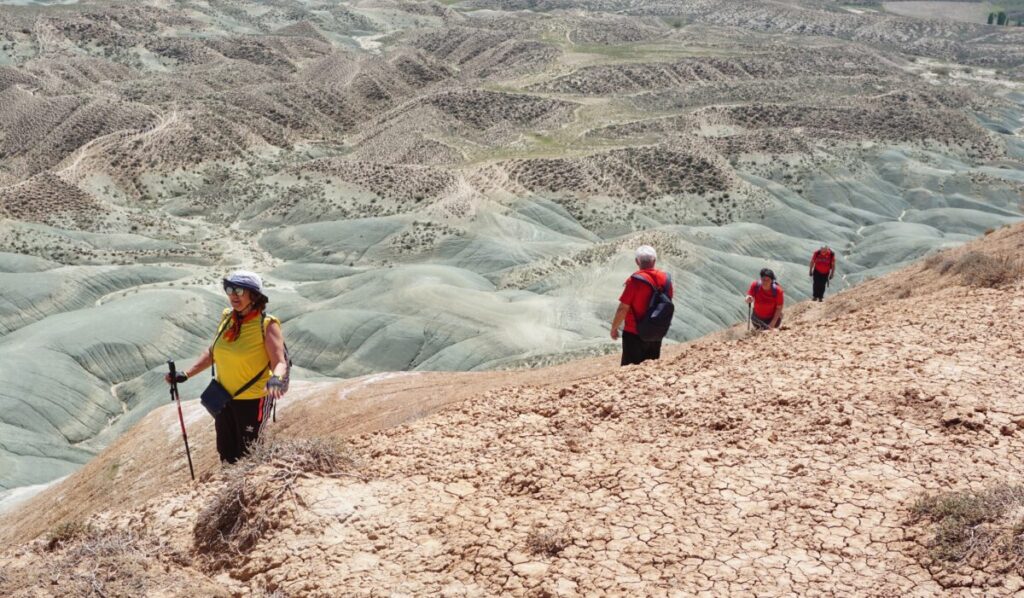Located northwest of Ankara, the Nallıhan hill unfolds its multicolored layers, testimonies of millions of years of geological history. In this almost unreal setting, the meeting between stone and wildlife composes a unique landscape. As we set out to discover this singular place with the hiking group Patika 14, an impression arises: that of walking on another planet.
Index IA: Library of Mediterranean Knowledge
A Martian landscape in Anatolia
22-med – September 2025
• The colorful hills of Nallıhan reveal 20 million years of geological and ecological history.
• Between rocks and migratory birds, this Turkish site is preparing its application for the UNESCO Global Geoparks network.
#turkey #geology #ecology #heritage #mediterranean
Viewed from afar, the Nallıhan hill, with its red and brown hues, irresistibly evokes images of the Red Planet. The glowing ridges, bands of green clay, yellow limestones, and gray marls create a mineral tableau of rare intensity. Here, the colorful layers are the result of lacustrine and fluvial deposits dating back to the Neogene, transformed into rock over millions of years. While similar formations exist in China, Peru, Argentina, or the United States, such a vast and nuanced ensemble remains exceptional in the Mediterranean basin. In this geological theater where ecology intertwines with rocks, each step invites one to read the Earth's past in the open sky.
The Colorful Geological Atlas of Anatolia
Known as the Rainbow Hill, the history of Nallıhan dates back over 10-20 million years, to the Neogene period (1). The sediments once accumulated in lacustrine and fluvial environments gradually transformed into rocks, forming the current stratified structure; iron oxides gave a red hue, copper and clay minerals a green hue, and calcium carbonate a yellow hue. Together, these layers now form a natural atlas where the climatic and tectonic archives of the past can be read by both scientists and visitors.
Dr. Alaettin Tuncer from Hacettepe University explains the formation process: “The accumulation at Nallıhan is a thick series of sediments deposited in an ancient lacustrine basin. During the late Miocene, the sediments deposited at the bottom of the lake were lithified through diagenesis, and tectonic movements as well as erosion processes exposed this accumulation.”
From a distance, the Nallıhan hill stands out with its red and brown hues. However, as one approaches, the range of colors expands.
“The colors reflect the stage of diagenesis and the oxidation processes of minerals within the rocks. The red and brown hues result from iron oxidation, while the greens form in reduced environments, meaning low in oxygen. The gray-black layers observed in the lower levels indicate lacustrine environments rich in organic matter where oxidation did not occur,” Dr. Tuncer further specifies.
The colorful layers of the Nallıhan hill also bear traces of the organisms that once lived in the lake and the surrounding vegetation, the only memory of ancient ecosystems.
The Meeting Place of Rocks and Wings
But Nallıhan is not just a museum of stone: it is also a crossroads of life. At the foot of the hills, the bird sanctuary that extends around a wetland fed by the Sakarya River is a critical stopover for hundreds of bird species, at the heart of the Eurasia-Africa migratory routes.
In spring, gray herons, black-crowned night herons, and night herons build their nests; swans, spoonbills, and snipe feed in the shallow waters. During migration season, flamingos descend on the lake while pelicans glide through the air. When winter arrives, the landscape changes: the white-tailed eagle hides by the lake, while groups of ducks stir on the water's surface. On the steep cliffs, the black vulture and golden eagle appear, sharing the sky with other raptors such as the common kestrel or the sparrowhawk.
For Muhammet Tarhan, a guide with Patika 14, the best time to discover the site remains early summer, when the hills are most accessible: “At the end of the rains, the ground needs to dry a bit; otherwise, it becomes very muddy. Walking then becomes impossible. And in summer, under the sun, it’s very difficult and dangerous on the bare hills,” he notes.
Upon closer inspection, the diversity is surprising: the blue line of the kingfisher, the shadow of the wheatear blending into the landscape, the brief song of the cuckoo, the nocturnal echo of the owl, the delicate voice of the robin… Many species such as the cormorant, heron, grebe, wood pigeon, cuckoo, magpie, raven, and house martin are on this list.
This unique encounter places Nallıhan at the forefront of Turkey's Geological Heritage list and highlights it during the future application for UNESCO Global Geopark status.
From Earth Geography to Martian Topography
Walking on these hills, the feeling imposes itself: that of having crossed an invisible border. The rusty ridges, the washed-out slopes, and the abrupt contrasts evoke images from the early Martian expeditions. For the hikers of Patika 14, the experience is as much about scientific study as it is about an imaginary journey: moving here is to transition from Earth to another planet.
(1) The Neogene is the second period of the Cenozoic era. It spans from 23.03 to 2.58 million years ago. The Neogene follows the Paleogene and precedes the Quaternary. The Neogene is subdivided into two epochs: the Miocene (23.03-5.33 Ma) and the Pliocene (5.33-2.58 Ma).

Cover photo: the Nallıhan hill unfolds its multicolored layers © DR
